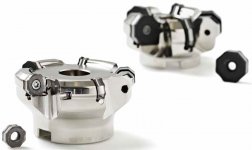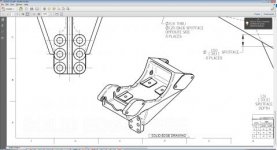Hey guys - looking for a new 6" face mill and some tough inserts for a certain application. Job is milling some cast steel - coming in about 300 BHN, believe it's also annealed. Between two operations we're milling off about 20 cubic inches of material total, and with the inserts we're running we're getting about 4 or 5 completed pieces before indexing. Hard to explain but there's a tricky part about the way the work sits on the fixture, there's two pads on either side getting milled down that are just kind of hanging out in space, and we're playing with the idea of some kind of jackscrew to put in there for some support. Anyways, for the time being we're fighting a bit of chatter on those surfaces.
Machinist hates indexing inserts and wants to know what else is out there for us to further limit the dead spindle time he's getting, and maybe run a bit faster while we're at it - currently running these (THLS130608R IN2530) about 350 RPM, 17 IPM. Tried out an OSG Phoenix already and it didn't go over particularly well.
Anyone have any good input for what to use in that kind of material (cough, Jashley, cough)?
Machinist hates indexing inserts and wants to know what else is out there for us to further limit the dead spindle time he's getting, and maybe run a bit faster while we're at it - currently running these (THLS130608R IN2530) about 350 RPM, 17 IPM. Tried out an OSG Phoenix already and it didn't go over particularly well.
Anyone have any good input for what to use in that kind of material (cough, Jashley, cough)?










